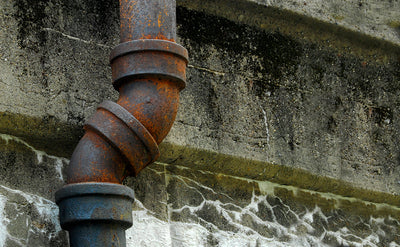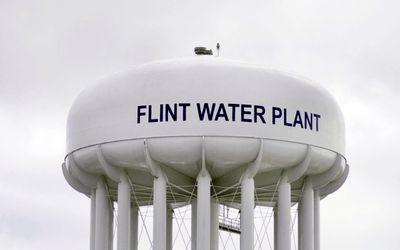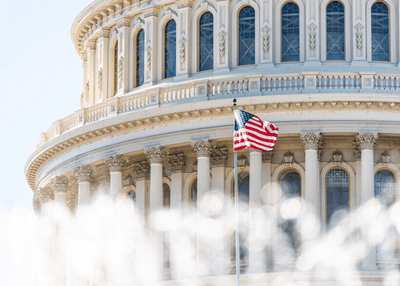Water Quality InformationWritten By Actual Experts
RSSAmerican's Can't Afford Their Water Bills

PFAS: The Other Contaminant From The Flint Water Crisis

Analies Dyjak, M.A. | Policy Nerd
Hydroviv's Policy Team has been keeping a close eye on water quality in Flint, Michigan, in the wake of their lead crisis beginning in 2014. A major problem that has been wildly underreported was the presence of Per and Polyfluoroalkyl Substances (PFAS) in Flint's municipal system at the time of the lead crisis.
What Happened In Flint, Michigan?
If you're unfamiliar with the Flint Lead Crisis, our team wrote an in-depth article breaking down the major events. In short, city officials switched the city's source water from Lake Huron to the Flint River in an effort to save money. The story that we're breaking today discusses a contaminant that was known to be present in the Flint River at the time it was being used as source water for the city.
Flint, Michigan’s Newest Problem: PFAS
A few years after the lead crisis in Flint, Michigan, the same afflicted city residents are now dealing with PFAS. Revitalizing Auto Communities Environmental Response Trust, also known as RACER, was created in 2011 after General Motors filed for Chapter 11 Bankruptcy. The goal of RACER was to address water pollution from various General Motors facilities, including discharges into the Flint River and surrounding groundwater wells. Because PFAS are not regulated, they were not included in GM’s National Pollution Discharge Elimination (NPDES) Permit.
The Michigan Department of Environment, Great Lakes, and Energy has acknowledged that PFAS pollution is of great concern in the Flint River, and could potentially threaten surrounding groundwater wells. Flint switched from Lake Huron to the corrosive Flint River, causing extreme levels of lead contamination and what’s now known as the “Flint Lead Crisis.” The science is now making clear Flint residents were being exposed to more than just lead. At the beginning of March, 2020, RACER announced they would begin work to reroute underground stormwater lines away from the Flint River. Due to COVID-19, these PFAS mitigation efforts have been postponed.
Other Articles We Think You Might Enjoy:Newark, NJ: The New Flint
How Did Hydroviv Water Filter Perform In A Duke University Study?
How Do I Know If I Have Lead Plumbing
Latest PFAS Legislation (Federal and State)

Analies Dyjak, M.A. | Policy Nerd
PFAS have been detected in tap water across the entire country. In an effort to reallocate funding to address the current pandemic, various mitigation projects have been postponed. While we agree a majority of funding and resources should be allocated to COVID-19, water improvement projects should not be completely ignored. We wanted to highlight recent state and federal legislation regarding PFAS contamination, as well as important mitigation measures that have recently been put on hold.
Newest PFAS Federal Legislation
The PFAS Action Act:
On January 10, 2020, The PFAS Action Act of 2019 passed the U.S. House of Representatives. The bill is now waiting to be voted on by the Senate. This bill would require EPA to set a national standard under the National Primary Drinking Water Standards for both PFOA and PFOS, triggering mandatory compliance by municipalities. Furthermore, the bill would require cities and towns across the country to reduce PFOA and PFOS in drinking water to levels set by EPA. The bill would also authorize $500 million over five years to help municipalities comply with the new PFAS standards.
On January 29th, 2020, Senators Bernie Sanders, Jeff Merkley, and Ed Markey, introduced The Preventing Future American Sickness (PFAS) Act. This bill would require EPA to designate all PFAS chemicals as “hazardous substances” under CERCLA. It would also require federal assistance to individuals with private wells that have been contaminated with PFAS. The PFAS Act does not, however, explicitly ask EPA to set federal drinking water standards for PFAS chemicals.
States Take Action on PFAS Contamination
Alaska: Alaska State Legislature introduced a bill that would require more municipal testing, provide public notices when PFAS (specifically in the form of firefighting foam) is being used, and provide clean water to those who have detected PFAS in their drinking water. Unfortunately, Alaska does not have enough state funding to set their own Maximum Contaminant Levels (MCLs), and therefore must wait for federal PFAS standards.
California: On February 6, 2020, California reduced its Response Levels (RLs) from 70 parts per trillion (combined PFAS) to 10 parts per trillion for PFOA and 40 parts per trillion for PFOS. If municipal concentrations exceed these levels, the public utility must notify residents within 30 days of receiving laboratory results. The California Water Board is also in the midst of completing a PFAS investigation.
Georgia: In April of 2019, Georgia prohibited the use of Class B fire retardants, which includes all PFAS chemicals. There are a few major exemptions included in House Bill 458 that make it extremely flawed. These exemptions include the use of Class B fire fighting foams in response to an emergency fire, as well as for training purposes, if the facility is built to prevent PFAS from being released into the environment.
Minnesota: In April of 2019, Minnesota lowered their health-based advisory level for PFOS from 27 parts per trillion to 15 parts per trillion. If a municipal water system has PFOS levels above 15 parts per trillion, the utility must notify residents.
New Hampshire: In July of 2019, New Hampshire adopted the most stringent standards for PFAS in drinking water in the country. PFOA=12 parts per trillion, PFNA=11 parts per trillion, PFOS=15 parts per trillion, and PFHxS=18 parts per trillion. However, in December, the Merrimack County Superior Court issued an injunction on the PFAS standards, claiming that the New Hampshire Department of Environmental Services did not adequately weigh costs and benefits.
New York: We recently wrote an in-depth article about New York’s response to PFAS contamination which can be found here.
Vermont: On May 16, 2019, Vermont’s Governor signed into law some of the most stringent PFAS standards in the country. Five combined PFAS variations (PFOA, PFOS, PFHxS, PFNA, and PFHpA) must be below 20 parts per trillion in state-wide public water systems.
Our Take:
While state and federal legislatures are still actively trying to make things happen regarding PFAS, several mitigation projects have been postponed. A reallocation of funds in response to COVID-19 is the responsible move. It’s also important to acknowledge that in the meantime, millions of American are still drinking contaminated water. Instead of looking at public health as a holistic entity, we are selectively responding to immediate threats and failing to prevent future exposure.
Other Articles We Think You Might Enjoy:How Did Hydroviv Perform in a Duke University PFAS Removal Study?
5 Drinking Water Contaminants You Should Know About
What Do TDS (ppm) Meters Tell Me About My Drinking Water?
How Is EPA Responding to COVID-19?

Analies Dyjak, M.A. | Policy Nerd
We wanted to make people aware of a recent policy change that has generated some pretty inflammatory headlines. Like other federal agencies, the Environmental Protection Agency (EPA) has issued a new policy that relaxes enforcement of some regulations during the COVID-19 emergency.
How Is EPA Responding to COVID-19?
The goal of EPA’s discretionary enforcement policy is to acknowledge that limited available personnel may make it difficult to carry out, enforce, and monitor regulated entities at the local and state level. In short, EPA will “exercise discretion” when enforcing certain environmental rules, including the Safe Drinking Water Act. The new policy will not enforce; compliance monitoring, integrity testing, sampling, laboratory analysis, training, and reporting or certification. All of these conditions are applicable to municipal tap water. From a public health perspective, this is a bit alarming! The enforcement section of the Safe Drinking Water Act ensures that all tap water across the country is safe for consumption. The official statement from EPA is as follows:
“EPA does not expect to seek penalties for noncompliance with routine monitoring and reporting obligations that are the result of the COVID-19 pandemic but does expect operators of public water systems to continue to ensure the safety of our drinking water supplies.”
How Will City Water Utilities Respond?
EPA’s new policy puts a lot of trust on industries and municipalities to act in “good faith” during this period of relaxed enforcement. While it’s our experience that the overwhelming majority of municipalities do work in good faith, there will always be “bad apples” who don’t follow the rules. We wanted to point out a few communities that have not acted in good faith in the past regarding drinking water.-
Flint, Michigan: It took over a year for the City of Flint to acknowledge that there was a problem with lead levels in their water during the now infamous Flint Lead Crisis.
-
Major Cities Employing “Cheats” To Circumvent EPA’s Lead & Copper Rule: In 2016, The Guardian exposed several municipalities who were participating in “lead cheats” to artificially lower lead levels in the public supply. Some of the larger municipalities included Chicago, Boston, and Philadelphia.
-
North Carolina and GenX: Chemours had been knowingly dumping GenX chemicals into the Cape Fear River for decades, which is the source water for dozens of surrounding North Carolina communities. Part of the legal retribution is to pay for water testing and filtration installation for all affected parties. On March 25, 2020, North Carolina Department of Environmental Quality announced that Chemours will suspend water testing and filtration installation in the Cape Fear basin, putting those residents at risk.
-
Newark, New Jersey: Newark, New Jersey detected lead levels that were on par with Flint, Michigan during the height of its lead crisis over the summer of 2019. The city failed to properly test the low-end water filters being distributed by the city, against lead levels found in Newark tap water. This resulted in residents being unknowingly further exposed to high lead levels.
-
Portland, Oregon: Lead levels in Portland, Oregon have been elevated for years. Worse, the city's annual Consumer Confidence Reports hides the lead collection data on the last page.
How Will EPA’s New COVID-19 Response Policy Affect Drinking Water?
Communities across the country are suspending ongoing drinking water improvement efforts to focus on COVID-19. We agree that this is an important step in protecting individuals from this deadly infectious disease, and that common sense measures should be in place. In response to COVID-19, EPA will follow the 2010 Drinking Water Enforcement Response Policy, which created a priority ranking system. In short, systems that have had several violations will receive more federal resources than systems with fewer violations or those in compliance.
Industries to “Self-Monitor” During COVID-19
Part of EPA’s response to COVID-19 is to reduce regulatory enforcement due to decreased available personnel. There’s reason to believe that fewer industrial checks and balances will increase the amount of pollution that ends up in source water. EPA regulates and monitors industrial behavior that may have a negative impact on human health and the environment. As it pertains to drinking water, EPA limits the amount of pollution that industries are allowed to release into water. Rivers, lakes, and groundwater are used as drinking water sources by municipalities across the country. These regulatory limits, also known as "pollutant loads", are one of the most important ways to ensure the effectiveness of water treatment. Most municipal water treatment facilities are typically not capable dealing with increased pollution.
Hydroviv Founder, Dr. Eric Roy, Testifies Before Congress

Hydroviv's Water Nerds
Hydroviv’s founder, Dr. Eric Roy was called as an expert witness to testify before the House Committee on Science, Space, and Technology - Investigations and Oversight Subcommittee. The topic of this hearing was aimed at solving the nationwide lead crisis, with particular emphasis on the crisis underway in Newark, New Jersey. Lead contamination in U.S. tap water remains a high priority for lawmakers, although current policies and solutions are not sufficient.
Dr. Roy shared the stage with fellow scientists, physicians, and engineers who are dedicated to solving the nationwide lead crisis. In his testimony, he laid out a framework for the Federal Government to align academics, government scientists, and technology developers to solve water quality problems in the same way that Federal Agencies do for high-priority security initiatives (also has significant experience).
We were honored that Dr. Roy was called on as a thought leader for such an important discussion by such a prestigious House Committee/Subcommittee. A transcript of the testimony can be found here.






